Assessment 3: Literature Review on Indigenous Australian Health Issues
VerifiedAdded on 2022/10/01
|8
|1826
|466
Literature Review
AI Summary
This literature review examines the significant health disparities experienced by Indigenous Australians, focusing on the impacts of historical, social, and political processes. The review delves into the historical context, including the effects of colonization and racism, and how these factors have shaped health outcomes. It also explores social determinants, such as poverty, inadequate housing, and limited access to healthcare, and their influence on the well-being of Indigenous communities. Furthermore, the review analyzes the role of political factors, including government policies and funding allocation, and their impact on Indigenous health. The author references multiple academic sources, including journal articles and research papers, to support the analysis and present a comprehensive understanding of the challenges and potential solutions to improve the health of Indigenous Australians. The paper concludes by highlighting the need for concerted efforts from both governmental bodies and the community to overcome the challenges.
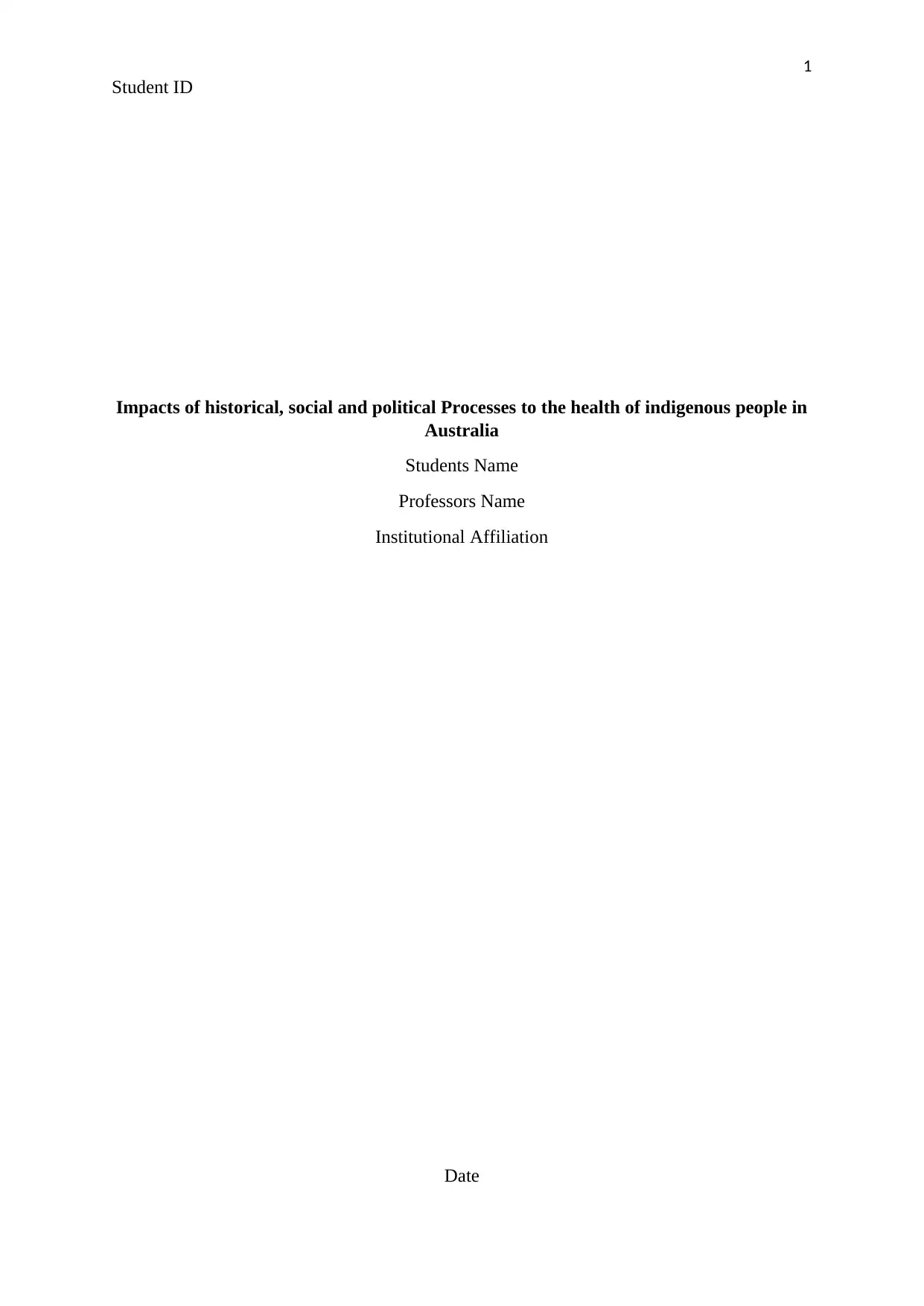
1
Student ID
Impacts of historical, social and political Processes to the health of indigenous people in
Australia
Students Name
Professors Name
Institutional Affiliation
Date
Student ID
Impacts of historical, social and political Processes to the health of indigenous people in
Australia
Students Name
Professors Name
Institutional Affiliation
Date
Paraphrase This Document
Need a fresh take? Get an instant paraphrase of this document with our AI Paraphraser
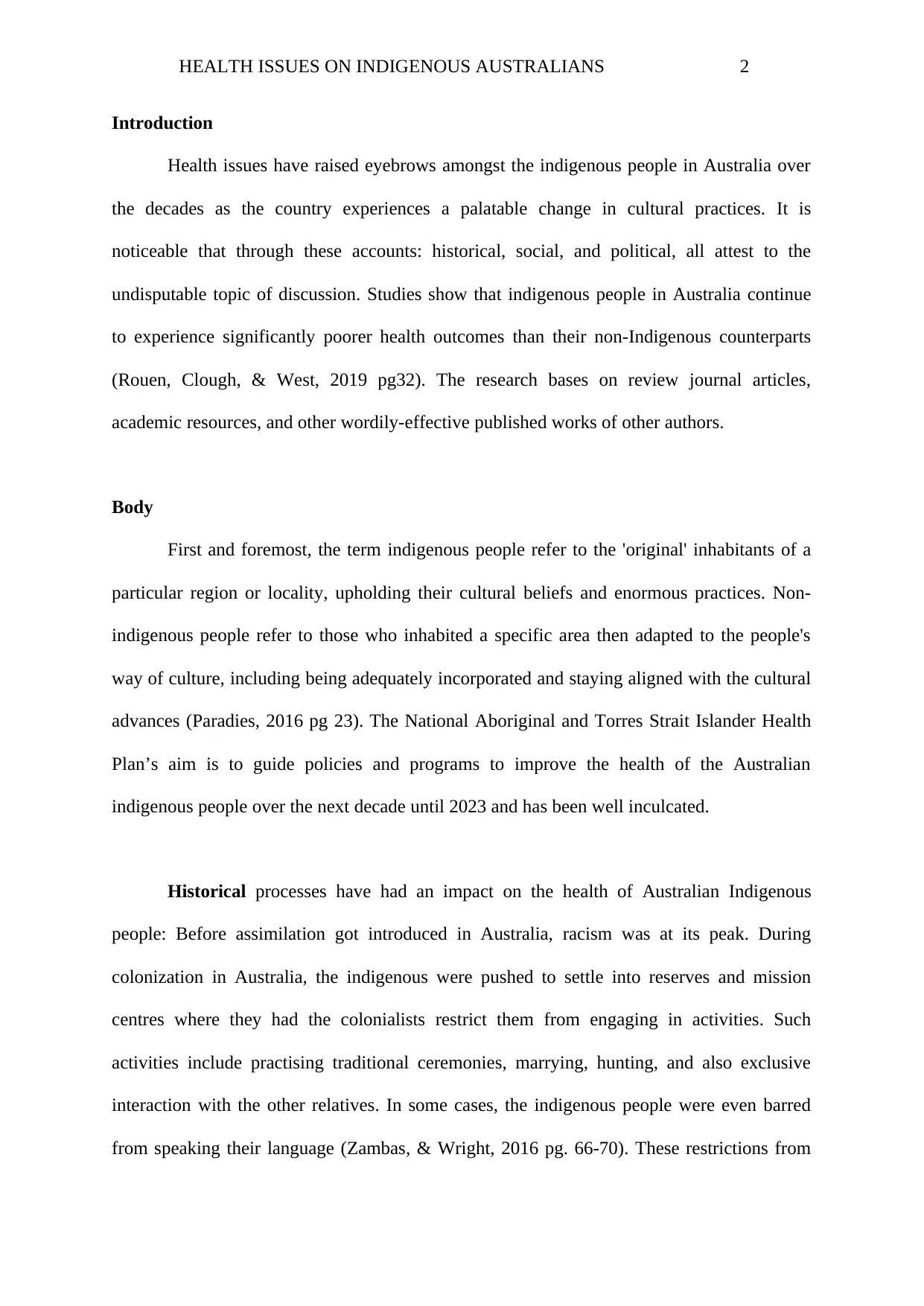
HEALTH ISSUES ON INDIGENOUS AUSTRALIANS 2
Introduction
Health issues have raised eyebrows amongst the indigenous people in Australia over
the decades as the country experiences a palatable change in cultural practices. It is
noticeable that through these accounts: historical, social, and political, all attest to the
undisputable topic of discussion. Studies show that indigenous people in Australia continue
to experience significantly poorer health outcomes than their non-Indigenous counterparts
(Rouen, Clough, & West, 2019 pg32). The research bases on review journal articles,
academic resources, and other wordily-effective published works of other authors.
Body
First and foremost, the term indigenous people refer to the 'original' inhabitants of a
particular region or locality, upholding their cultural beliefs and enormous practices. Non-
indigenous people refer to those who inhabited a specific area then adapted to the people's
way of culture, including being adequately incorporated and staying aligned with the cultural
advances (Paradies, 2016 pg 23). The National Aboriginal and Torres Strait Islander Health
Plan’s aim is to guide policies and programs to improve the health of the Australian
indigenous people over the next decade until 2023 and has been well inculcated.
Historical processes have had an impact on the health of Australian Indigenous
people: Before assimilation got introduced in Australia, racism was at its peak. During
colonization in Australia, the indigenous were pushed to settle into reserves and mission
centres where they had the colonialists restrict them from engaging in activities. Such
activities include practising traditional ceremonies, marrying, hunting, and also exclusive
interaction with the other relatives. In some cases, the indigenous people were even barred
from speaking their language (Zambas, & Wright, 2016 pg. 66-70). These restrictions from
Introduction
Health issues have raised eyebrows amongst the indigenous people in Australia over
the decades as the country experiences a palatable change in cultural practices. It is
noticeable that through these accounts: historical, social, and political, all attest to the
undisputable topic of discussion. Studies show that indigenous people in Australia continue
to experience significantly poorer health outcomes than their non-Indigenous counterparts
(Rouen, Clough, & West, 2019 pg32). The research bases on review journal articles,
academic resources, and other wordily-effective published works of other authors.
Body
First and foremost, the term indigenous people refer to the 'original' inhabitants of a
particular region or locality, upholding their cultural beliefs and enormous practices. Non-
indigenous people refer to those who inhabited a specific area then adapted to the people's
way of culture, including being adequately incorporated and staying aligned with the cultural
advances (Paradies, 2016 pg 23). The National Aboriginal and Torres Strait Islander Health
Plan’s aim is to guide policies and programs to improve the health of the Australian
indigenous people over the next decade until 2023 and has been well inculcated.
Historical processes have had an impact on the health of Australian Indigenous
people: Before assimilation got introduced in Australia, racism was at its peak. During
colonization in Australia, the indigenous were pushed to settle into reserves and mission
centres where they had the colonialists restrict them from engaging in activities. Such
activities include practising traditional ceremonies, marrying, hunting, and also exclusive
interaction with the other relatives. In some cases, the indigenous people were even barred
from speaking their language (Zambas, & Wright, 2016 pg. 66-70). These restrictions from
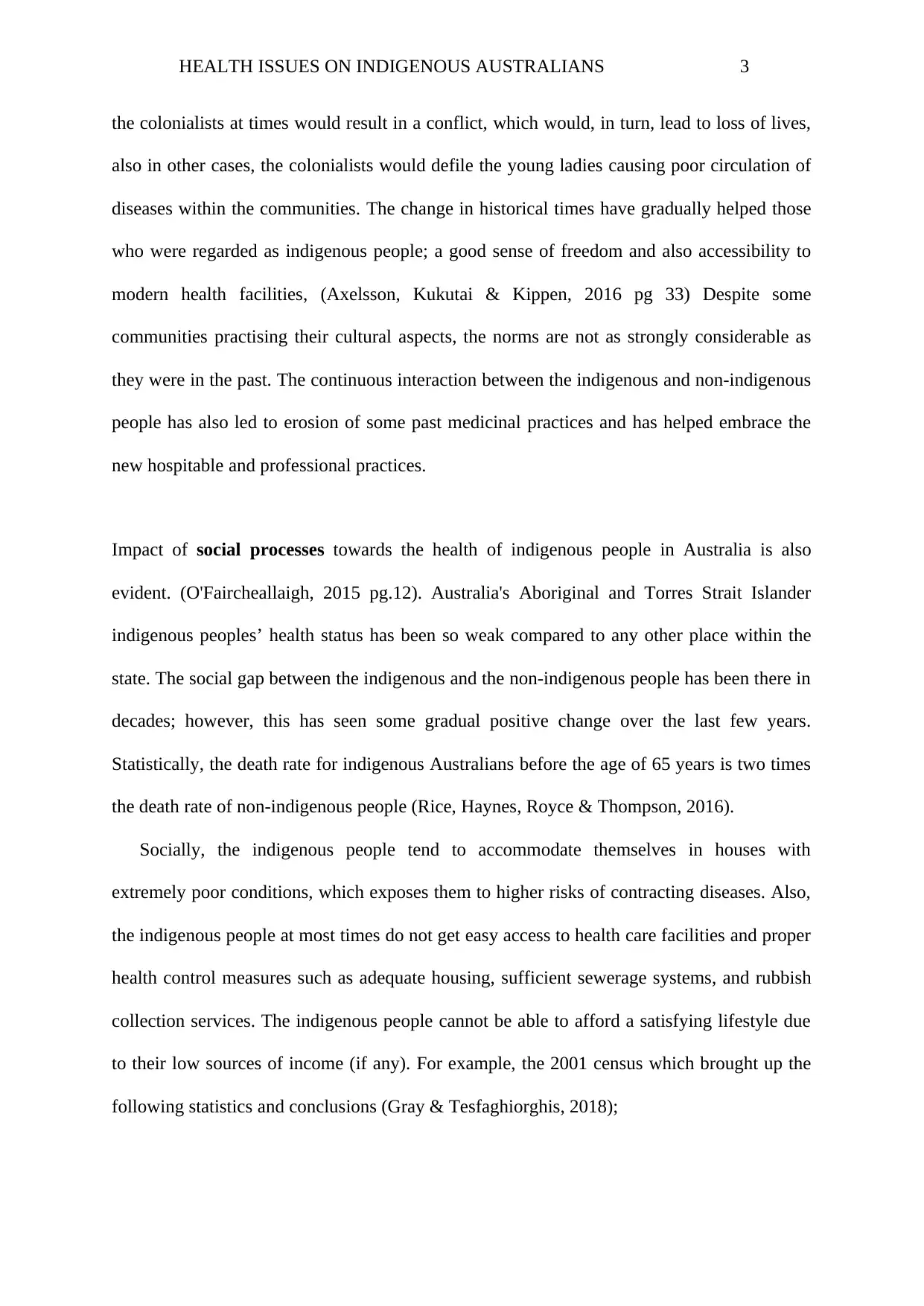
HEALTH ISSUES ON INDIGENOUS AUSTRALIANS 3
the colonialists at times would result in a conflict, which would, in turn, lead to loss of lives,
also in other cases, the colonialists would defile the young ladies causing poor circulation of
diseases within the communities. The change in historical times have gradually helped those
who were regarded as indigenous people; a good sense of freedom and also accessibility to
modern health facilities, (Axelsson, Kukutai & Kippen, 2016 pg 33) Despite some
communities practising their cultural aspects, the norms are not as strongly considerable as
they were in the past. The continuous interaction between the indigenous and non-indigenous
people has also led to erosion of some past medicinal practices and has helped embrace the
new hospitable and professional practices.
Impact of social processes towards the health of indigenous people in Australia is also
evident. (O'Faircheallaigh, 2015 pg.12). Australia's Aboriginal and Torres Strait Islander
indigenous peoples’ health status has been so weak compared to any other place within the
state. The social gap between the indigenous and the non-indigenous people has been there in
decades; however, this has seen some gradual positive change over the last few years.
Statistically, the death rate for indigenous Australians before the age of 65 years is two times
the death rate of non-indigenous people (Rice, Haynes, Royce & Thompson, 2016).
Socially, the indigenous people tend to accommodate themselves in houses with
extremely poor conditions, which exposes them to higher risks of contracting diseases. Also,
the indigenous people at most times do not get easy access to health care facilities and proper
health control measures such as adequate housing, sufficient sewerage systems, and rubbish
collection services. The indigenous people cannot be able to afford a satisfying lifestyle due
to their low sources of income (if any). For example, the 2001 census which brought up the
following statistics and conclusions (Gray & Tesfaghiorghis, 2018);
the colonialists at times would result in a conflict, which would, in turn, lead to loss of lives,
also in other cases, the colonialists would defile the young ladies causing poor circulation of
diseases within the communities. The change in historical times have gradually helped those
who were regarded as indigenous people; a good sense of freedom and also accessibility to
modern health facilities, (Axelsson, Kukutai & Kippen, 2016 pg 33) Despite some
communities practising their cultural aspects, the norms are not as strongly considerable as
they were in the past. The continuous interaction between the indigenous and non-indigenous
people has also led to erosion of some past medicinal practices and has helped embrace the
new hospitable and professional practices.
Impact of social processes towards the health of indigenous people in Australia is also
evident. (O'Faircheallaigh, 2015 pg.12). Australia's Aboriginal and Torres Strait Islander
indigenous peoples’ health status has been so weak compared to any other place within the
state. The social gap between the indigenous and the non-indigenous people has been there in
decades; however, this has seen some gradual positive change over the last few years.
Statistically, the death rate for indigenous Australians before the age of 65 years is two times
the death rate of non-indigenous people (Rice, Haynes, Royce & Thompson, 2016).
Socially, the indigenous people tend to accommodate themselves in houses with
extremely poor conditions, which exposes them to higher risks of contracting diseases. Also,
the indigenous people at most times do not get easy access to health care facilities and proper
health control measures such as adequate housing, sufficient sewerage systems, and rubbish
collection services. The indigenous people cannot be able to afford a satisfying lifestyle due
to their low sources of income (if any). For example, the 2001 census which brought up the
following statistics and conclusions (Gray & Tesfaghiorghis, 2018);
⊘ This is a preview!⊘
Do you want full access?
Subscribe today to unlock all pages.

Trusted by 1+ million students worldwide
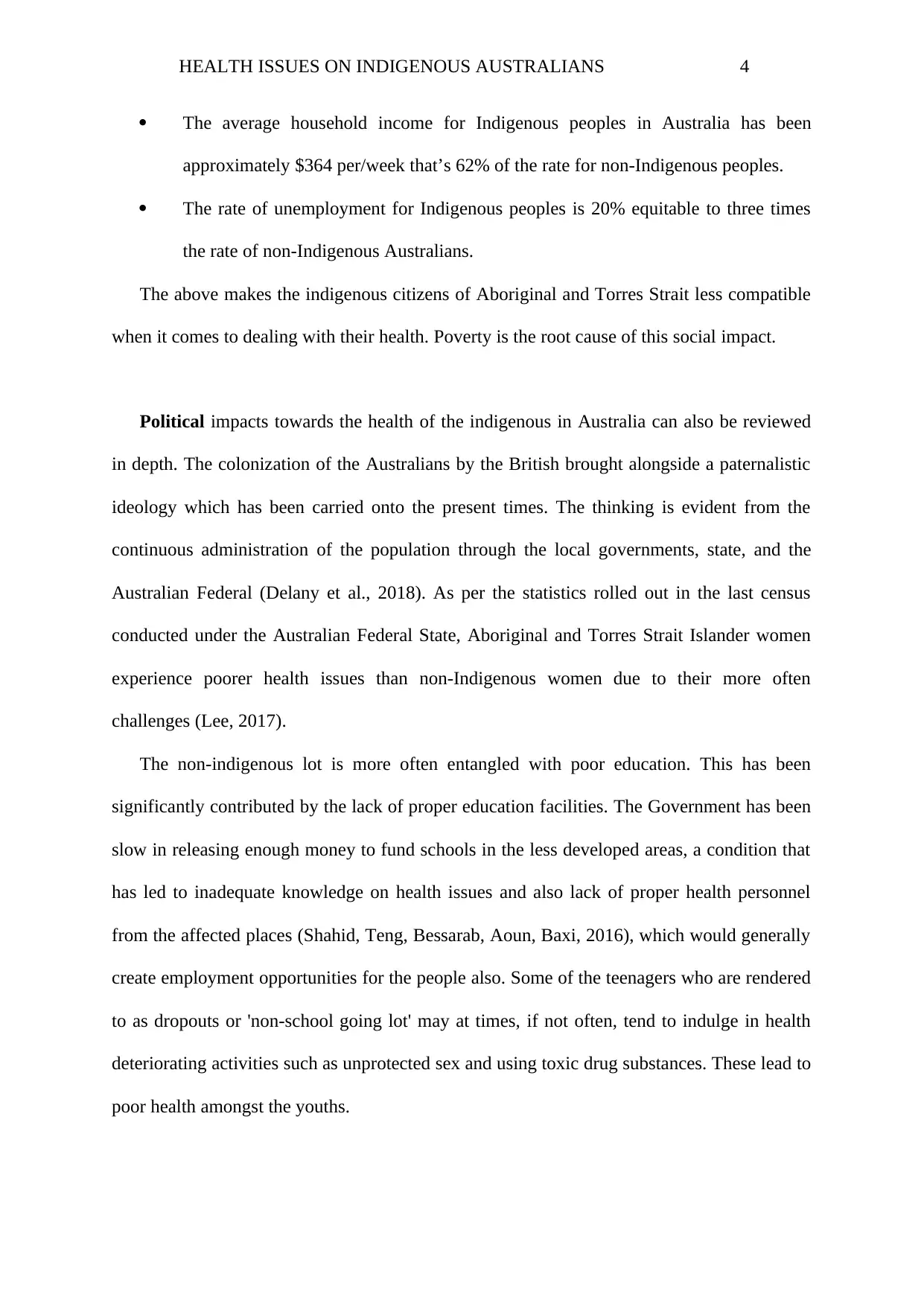
HEALTH ISSUES ON INDIGENOUS AUSTRALIANS 4
The average household income for Indigenous peoples in Australia has been
approximately $364 per/week that’s 62% of the rate for non-Indigenous peoples.
The rate of unemployment for Indigenous peoples is 20% equitable to three times
the rate of non-Indigenous Australians.
The above makes the indigenous citizens of Aboriginal and Torres Strait less compatible
when it comes to dealing with their health. Poverty is the root cause of this social impact.
Political impacts towards the health of the indigenous in Australia can also be reviewed
in depth. The colonization of the Australians by the British brought alongside a paternalistic
ideology which has been carried onto the present times. The thinking is evident from the
continuous administration of the population through the local governments, state, and the
Australian Federal (Delany et al., 2018). As per the statistics rolled out in the last census
conducted under the Australian Federal State, Aboriginal and Torres Strait Islander women
experience poorer health issues than non-Indigenous women due to their more often
challenges (Lee, 2017).
The non-indigenous lot is more often entangled with poor education. This has been
significantly contributed by the lack of proper education facilities. The Government has been
slow in releasing enough money to fund schools in the less developed areas, a condition that
has led to inadequate knowledge on health issues and also lack of proper health personnel
from the affected places (Shahid, Teng, Bessarab, Aoun, Baxi, 2016), which would generally
create employment opportunities for the people also. Some of the teenagers who are rendered
to as dropouts or 'non-school going lot' may at times, if not often, tend to indulge in health
deteriorating activities such as unprotected sex and using toxic drug substances. These lead to
poor health amongst the youths.
The average household income for Indigenous peoples in Australia has been
approximately $364 per/week that’s 62% of the rate for non-Indigenous peoples.
The rate of unemployment for Indigenous peoples is 20% equitable to three times
the rate of non-Indigenous Australians.
The above makes the indigenous citizens of Aboriginal and Torres Strait less compatible
when it comes to dealing with their health. Poverty is the root cause of this social impact.
Political impacts towards the health of the indigenous in Australia can also be reviewed
in depth. The colonization of the Australians by the British brought alongside a paternalistic
ideology which has been carried onto the present times. The thinking is evident from the
continuous administration of the population through the local governments, state, and the
Australian Federal (Delany et al., 2018). As per the statistics rolled out in the last census
conducted under the Australian Federal State, Aboriginal and Torres Strait Islander women
experience poorer health issues than non-Indigenous women due to their more often
challenges (Lee, 2017).
The non-indigenous lot is more often entangled with poor education. This has been
significantly contributed by the lack of proper education facilities. The Government has been
slow in releasing enough money to fund schools in the less developed areas, a condition that
has led to inadequate knowledge on health issues and also lack of proper health personnel
from the affected places (Shahid, Teng, Bessarab, Aoun, Baxi, 2016), which would generally
create employment opportunities for the people also. Some of the teenagers who are rendered
to as dropouts or 'non-school going lot' may at times, if not often, tend to indulge in health
deteriorating activities such as unprotected sex and using toxic drug substances. These lead to
poor health amongst the youths.
Paraphrase This Document
Need a fresh take? Get an instant paraphrase of this document with our AI Paraphraser
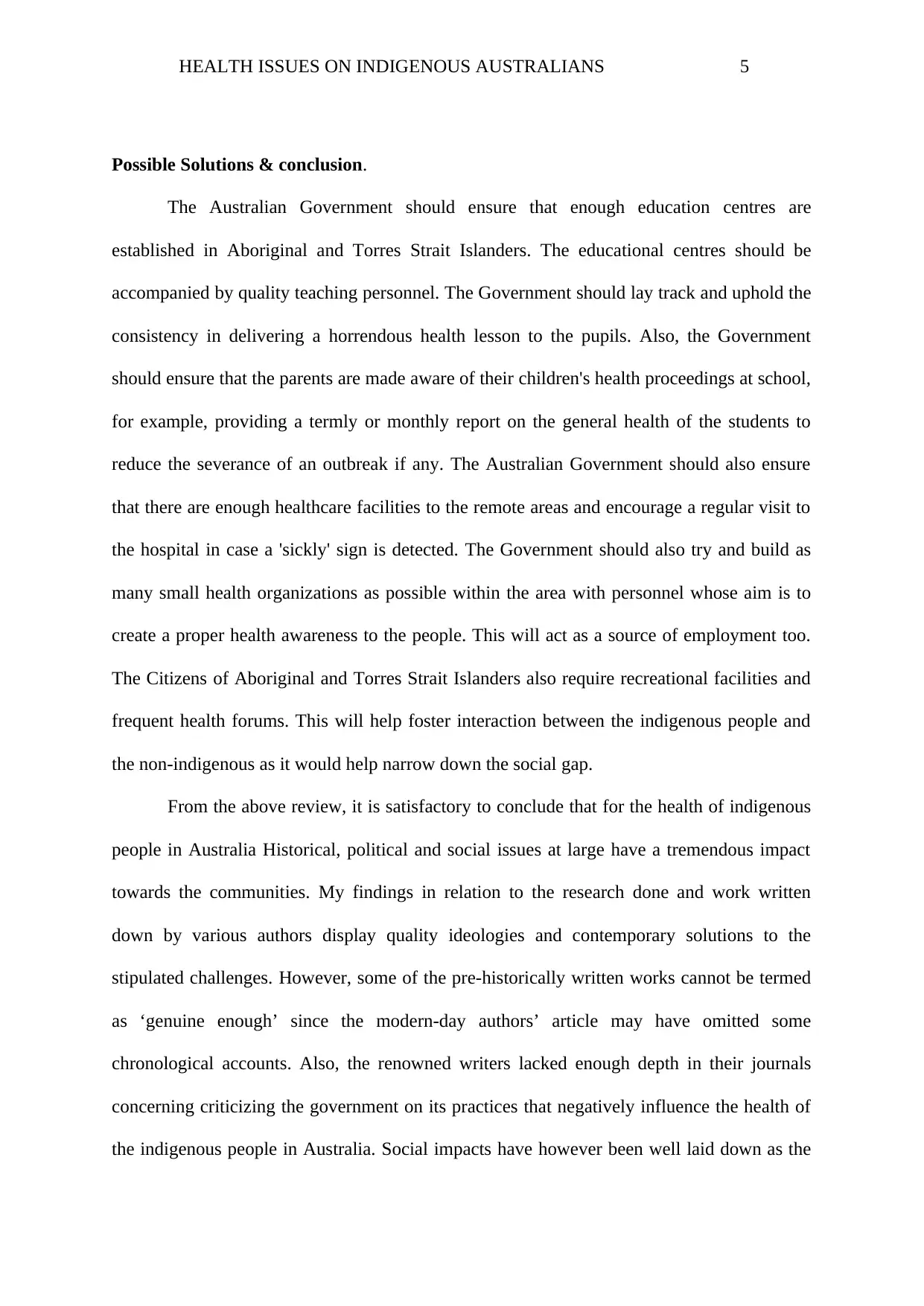
HEALTH ISSUES ON INDIGENOUS AUSTRALIANS 5
Possible Solutions & conclusion.
The Australian Government should ensure that enough education centres are
established in Aboriginal and Torres Strait Islanders. The educational centres should be
accompanied by quality teaching personnel. The Government should lay track and uphold the
consistency in delivering a horrendous health lesson to the pupils. Also, the Government
should ensure that the parents are made aware of their children's health proceedings at school,
for example, providing a termly or monthly report on the general health of the students to
reduce the severance of an outbreak if any. The Australian Government should also ensure
that there are enough healthcare facilities to the remote areas and encourage a regular visit to
the hospital in case a 'sickly' sign is detected. The Government should also try and build as
many small health organizations as possible within the area with personnel whose aim is to
create a proper health awareness to the people. This will act as a source of employment too.
The Citizens of Aboriginal and Torres Strait Islanders also require recreational facilities and
frequent health forums. This will help foster interaction between the indigenous people and
the non-indigenous as it would help narrow down the social gap.
From the above review, it is satisfactory to conclude that for the health of indigenous
people in Australia Historical, political and social issues at large have a tremendous impact
towards the communities. My findings in relation to the research done and work written
down by various authors display quality ideologies and contemporary solutions to the
stipulated challenges. However, some of the pre-historically written works cannot be termed
as ‘genuine enough’ since the modern-day authors’ article may have omitted some
chronological accounts. Also, the renowned writers lacked enough depth in their journals
concerning criticizing the government on its practices that negatively influence the health of
the indigenous people in Australia. Social impacts have however been well laid down as the
Possible Solutions & conclusion.
The Australian Government should ensure that enough education centres are
established in Aboriginal and Torres Strait Islanders. The educational centres should be
accompanied by quality teaching personnel. The Government should lay track and uphold the
consistency in delivering a horrendous health lesson to the pupils. Also, the Government
should ensure that the parents are made aware of their children's health proceedings at school,
for example, providing a termly or monthly report on the general health of the students to
reduce the severance of an outbreak if any. The Australian Government should also ensure
that there are enough healthcare facilities to the remote areas and encourage a regular visit to
the hospital in case a 'sickly' sign is detected. The Government should also try and build as
many small health organizations as possible within the area with personnel whose aim is to
create a proper health awareness to the people. This will act as a source of employment too.
The Citizens of Aboriginal and Torres Strait Islanders also require recreational facilities and
frequent health forums. This will help foster interaction between the indigenous people and
the non-indigenous as it would help narrow down the social gap.
From the above review, it is satisfactory to conclude that for the health of indigenous
people in Australia Historical, political and social issues at large have a tremendous impact
towards the communities. My findings in relation to the research done and work written
down by various authors display quality ideologies and contemporary solutions to the
stipulated challenges. However, some of the pre-historically written works cannot be termed
as ‘genuine enough’ since the modern-day authors’ article may have omitted some
chronological accounts. Also, the renowned writers lacked enough depth in their journals
concerning criticizing the government on its practices that negatively influence the health of
the indigenous people in Australia. Social impacts have however been well laid down as the
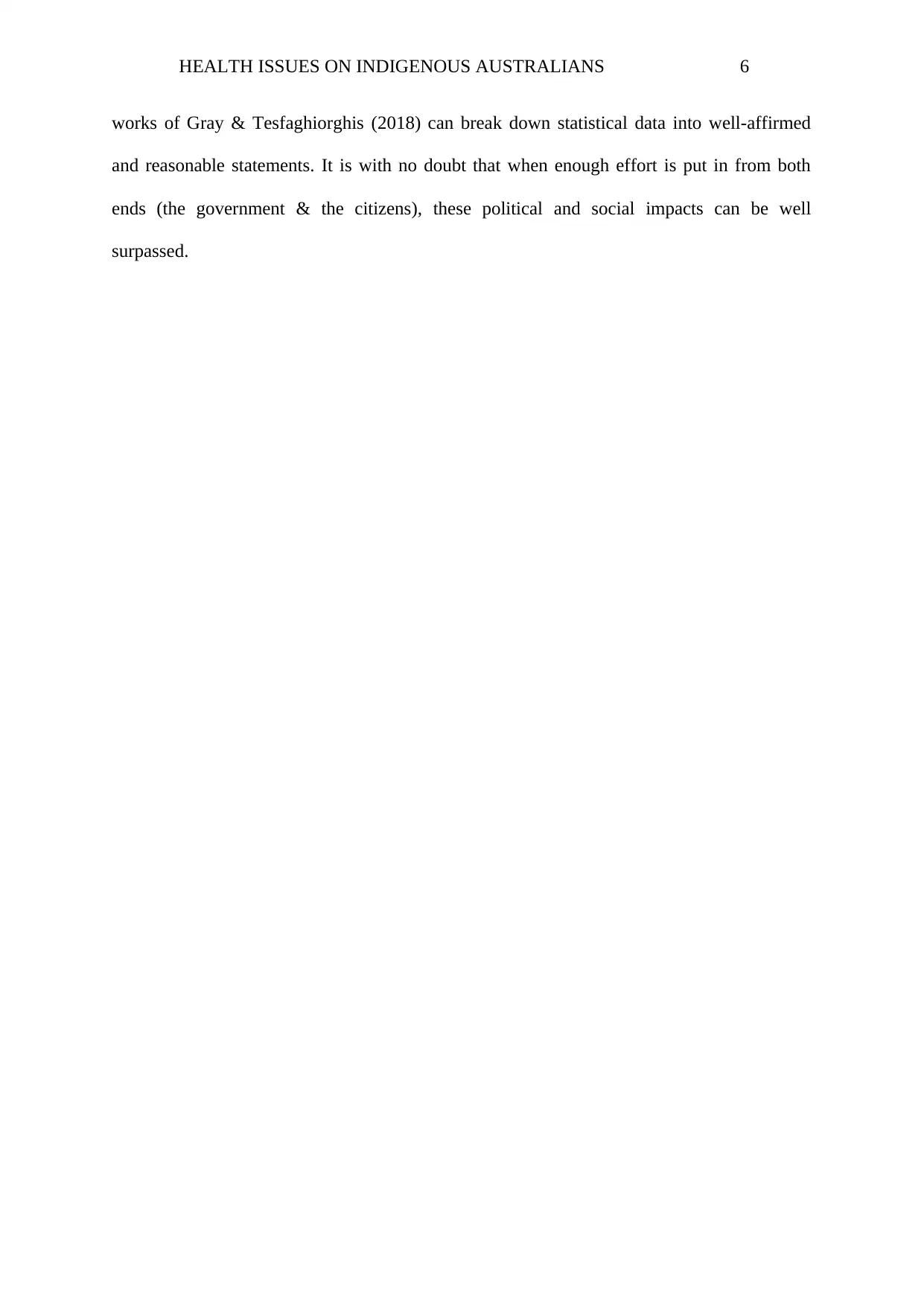
HEALTH ISSUES ON INDIGENOUS AUSTRALIANS 6
works of Gray & Tesfaghiorghis (2018) can break down statistical data into well-affirmed
and reasonable statements. It is with no doubt that when enough effort is put in from both
ends (the government & the citizens), these political and social impacts can be well
surpassed.
works of Gray & Tesfaghiorghis (2018) can break down statistical data into well-affirmed
and reasonable statements. It is with no doubt that when enough effort is put in from both
ends (the government & the citizens), these political and social impacts can be well
surpassed.
⊘ This is a preview!⊘
Do you want full access?
Subscribe today to unlock all pages.

Trusted by 1+ million students worldwide
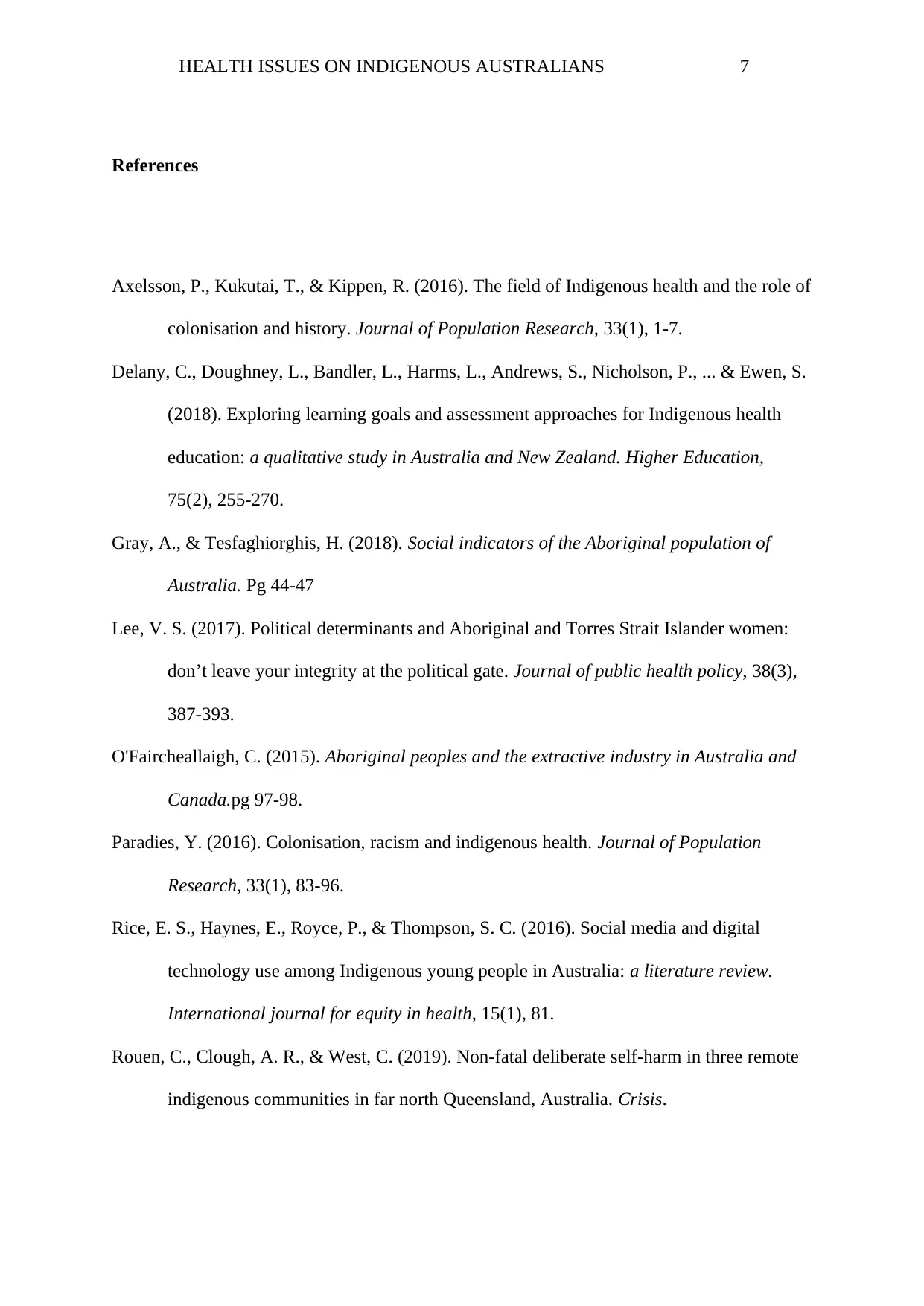
HEALTH ISSUES ON INDIGENOUS AUSTRALIANS 7
References
Axelsson, P., Kukutai, T., & Kippen, R. (2016). The field of Indigenous health and the role of
colonisation and history. Journal of Population Research, 33(1), 1-7.
Delany, C., Doughney, L., Bandler, L., Harms, L., Andrews, S., Nicholson, P., ... & Ewen, S.
(2018). Exploring learning goals and assessment approaches for Indigenous health
education: a qualitative study in Australia and New Zealand. Higher Education,
75(2), 255-270.
Gray, A., & Tesfaghiorghis, H. (2018). Social indicators of the Aboriginal population of
Australia. Pg 44-47
Lee, V. S. (2017). Political determinants and Aboriginal and Torres Strait Islander women:
don’t leave your integrity at the political gate. Journal of public health policy, 38(3),
387-393.
O'Faircheallaigh, C. (2015). Aboriginal peoples and the extractive industry in Australia and
Canada.pg 97-98.
Paradies, Y. (2016). Colonisation, racism and indigenous health. Journal of Population
Research, 33(1), 83-96.
Rice, E. S., Haynes, E., Royce, P., & Thompson, S. C. (2016). Social media and digital
technology use among Indigenous young people in Australia: a literature review.
International journal for equity in health, 15(1), 81.
Rouen, C., Clough, A. R., & West, C. (2019). Non-fatal deliberate self-harm in three remote
indigenous communities in far north Queensland, Australia. Crisis.
References
Axelsson, P., Kukutai, T., & Kippen, R. (2016). The field of Indigenous health and the role of
colonisation and history. Journal of Population Research, 33(1), 1-7.
Delany, C., Doughney, L., Bandler, L., Harms, L., Andrews, S., Nicholson, P., ... & Ewen, S.
(2018). Exploring learning goals and assessment approaches for Indigenous health
education: a qualitative study in Australia and New Zealand. Higher Education,
75(2), 255-270.
Gray, A., & Tesfaghiorghis, H. (2018). Social indicators of the Aboriginal population of
Australia. Pg 44-47
Lee, V. S. (2017). Political determinants and Aboriginal and Torres Strait Islander women:
don’t leave your integrity at the political gate. Journal of public health policy, 38(3),
387-393.
O'Faircheallaigh, C. (2015). Aboriginal peoples and the extractive industry in Australia and
Canada.pg 97-98.
Paradies, Y. (2016). Colonisation, racism and indigenous health. Journal of Population
Research, 33(1), 83-96.
Rice, E. S., Haynes, E., Royce, P., & Thompson, S. C. (2016). Social media and digital
technology use among Indigenous young people in Australia: a literature review.
International journal for equity in health, 15(1), 81.
Rouen, C., Clough, A. R., & West, C. (2019). Non-fatal deliberate self-harm in three remote
indigenous communities in far north Queensland, Australia. Crisis.
Paraphrase This Document
Need a fresh take? Get an instant paraphrase of this document with our AI Paraphraser
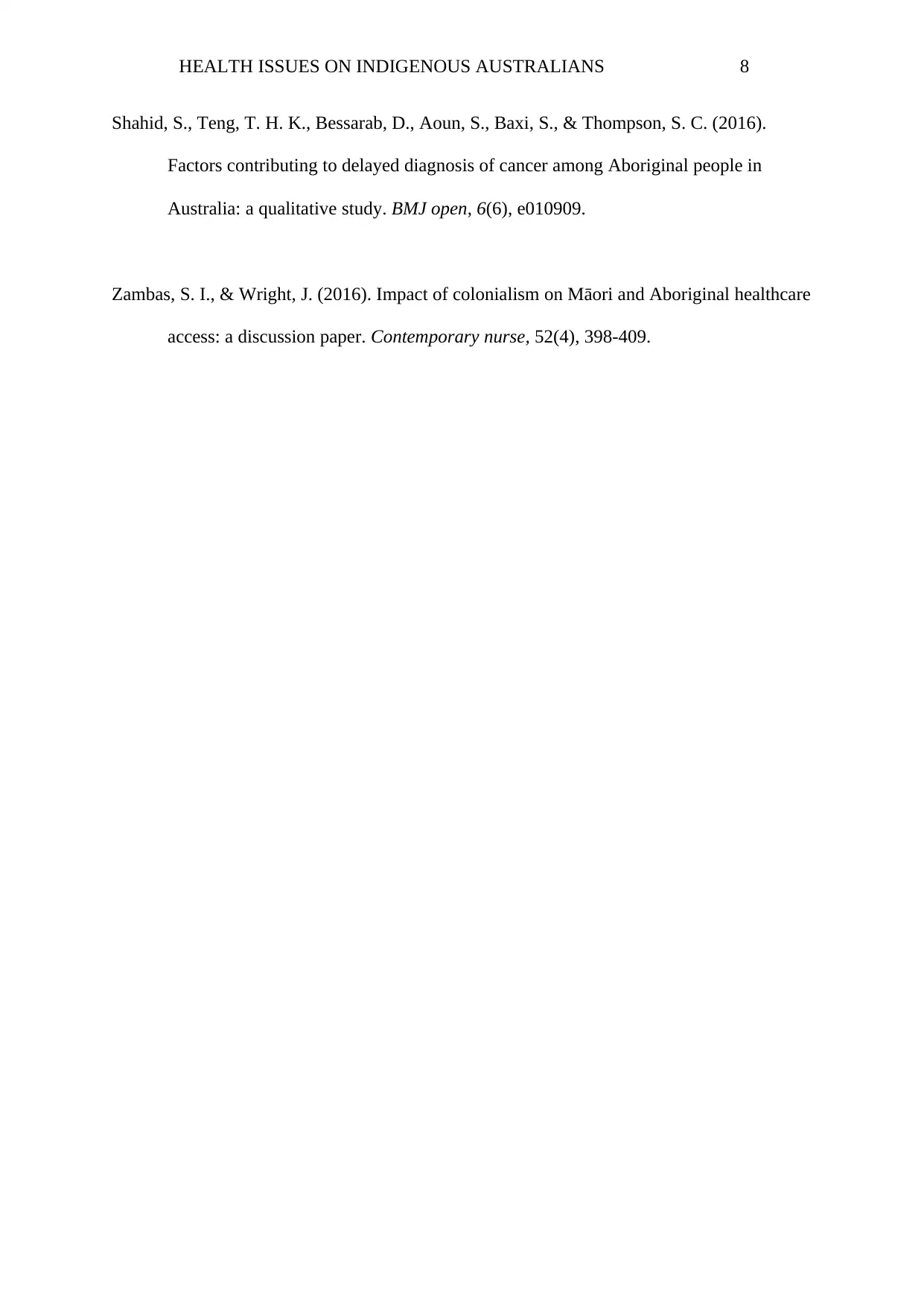
HEALTH ISSUES ON INDIGENOUS AUSTRALIANS 8
Shahid, S., Teng, T. H. K., Bessarab, D., Aoun, S., Baxi, S., & Thompson, S. C. (2016).
Factors contributing to delayed diagnosis of cancer among Aboriginal people in
Australia: a qualitative study. BMJ open, 6(6), e010909.
Zambas, S. I., & Wright, J. (2016). Impact of colonialism on Māori and Aboriginal healthcare
access: a discussion paper. Contemporary nurse, 52(4), 398-409.
Shahid, S., Teng, T. H. K., Bessarab, D., Aoun, S., Baxi, S., & Thompson, S. C. (2016).
Factors contributing to delayed diagnosis of cancer among Aboriginal people in
Australia: a qualitative study. BMJ open, 6(6), e010909.
Zambas, S. I., & Wright, J. (2016). Impact of colonialism on Māori and Aboriginal healthcare
access: a discussion paper. Contemporary nurse, 52(4), 398-409.
1 out of 8
Related Documents
Your All-in-One AI-Powered Toolkit for Academic Success.
+13062052269
info@desklib.com
Available 24*7 on WhatsApp / Email
![[object Object]](/_next/static/media/star-bottom.7253800d.svg)
Unlock your academic potential
Copyright © 2020–2025 A2Z Services. All Rights Reserved. Developed and managed by ZUCOL.





